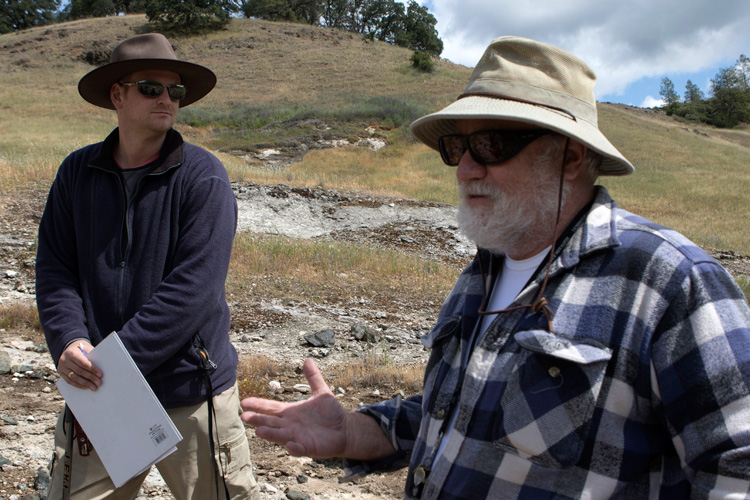Project taps amateur botanists for green treasure hunt

September 16, 2015
Botanists in UC Berkeley’s herbaria hosted a plant treasure hunt this past spring to tap the expertise of the California Native Plant Society, hoping to locate, map and collect some of the state’s rare and endangered plants.

UC Berkeley botanists Brent Mishler (right) and Andrew Thornhill aim to apply modern genetic analysis techniques to reconstruct the family tree of California’s plants. Lobsang Wangdu photo.
The Rare Plant Treasure Hunt was supported by the California Plant Phylodiversity Project, which is led by Brent Mishler, Bruce Baldwin and David Ackerly, all UC Berkeley professors of integrative biology, and funded by the National Science Foundation. The project’s goal, Misher said, is to understand California’s dizzying plant diversity. And who better to help than the state’s most enthusiastic amateur botanists?
“In California there’s an army of people represented by the California Native Plant Society who are interested in plants and enthusiastic about conservation,” said Mishler, director of UC Berkeley’s University and Jepson Herbaria. “We thought if we combined our project with the expertise these folks have in finding plants, we could fill in the missing data we need and train a large group of people in modern techniques of biodiversity assessment.”
Nearly 30 citizen scientists turned out for the green treasure hunt at the Donald and Sylvia McLaughlin Natural Reserve, which straddles Napa, Lake and Yolo counties and is one of 39 sites operated by the University of California’s Natural Reserve System.
All told, the attendees found at least five species on the California Native Plant Society’s rare list, including Jepson’s milk-vetch (Astragalus rattanii var. jepsonianus), swamp larkspur (Delphinium uliginosum), bare monkeyflower (Mimulus nudatus) and most likely Tracy’s clarkia (Clarkia gracilis subp. tracyi).
“I’ve taken plant collecting classes before, but learning the meaning for it in a larger context is really exciting to me,” said one of the participants, Leslie Burkhart, who had driven all the way from Siskyou County at the Oregon border to attend the event.
Mishler was pleased, pointing out that discovering where genetic lineages are found can also aid in conservation.
“We can use this information to identify places where there are branches of the phylogenetic tree not covered by preserves. Then we can design parks and protections to fill in those gaps,” Mishler said.
To read more about the Rare Plant Treasure Hunt and the California Plant Phylodiversity Project, link to the full story on the UC Natural Reserve System’s website.